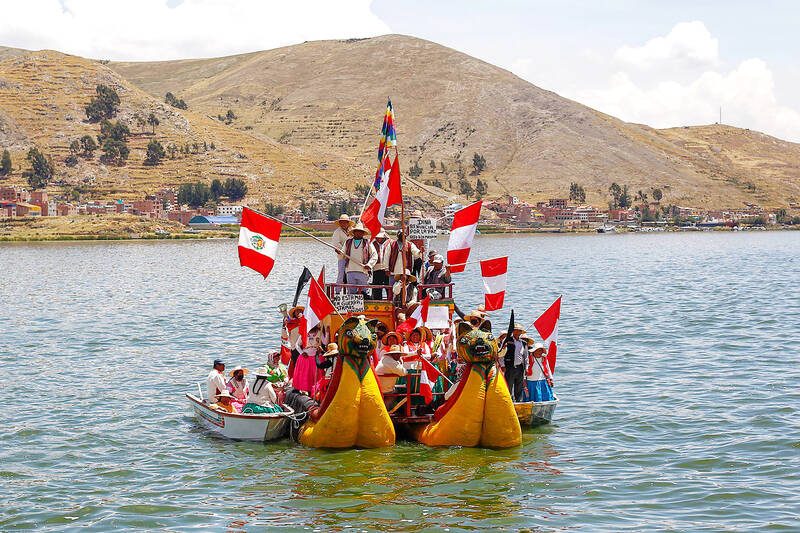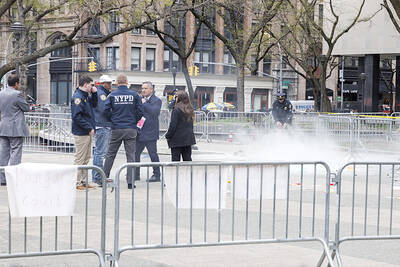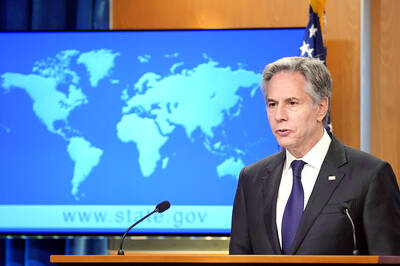Thousands of protesters took to the streets of Peru’s capital, and were met with volleys of tear gas and pellets amid clashes with security forces just hours after Peruvian President Dina Boluarte called for a “truce” in almost two months of protests.
The antigovernment protest on Tuesday was the largest — and most violent — since Thursday last week, when large groups of people, many from remote Andean regions, descended on the capital to demand Boluarte’s resignation, immediate elections and the dissolution of congress.
“We can’t have a truce when she doesn’t tell the truth,” Blanca Espana Mesa, 48, said of Boluarte.

Photo: AFP
Even though her eyes were watering from the tear gas, Espana Mesa said she was “happy because a lot of people came today. It’s as if people have woken up.”
Before last week, most of the large antigovernment protests that followed the ouster of Peruvian president Pedro Castillo took place in remote regions of the nation, largely in the south, exposing deep division between residents of the capital and the long-neglected countryside.
The crisis that has sparked Peru’s worst political violence in more than two decades began when Castillo, Peru’s first leader from a rural Andean background, tried to short-circuit the third impeachment proceeding of his young administration by ordering Congress dissolved on Dec. 7.
Lawmakers impeached him instead, the national police arrested him before he could find sanctuary and Boluarte, who was his vice president, was sworn in.
Since then, 56 people have died amid the unrest involving Castillo’s supporters, 45 of whom died in direct clashes with security forces, Peru’s ombudsman said. None of the deaths have been in Lima.
On Tuesday, police fired round after round of tear gas as they blocked the passage of protesters, who seemed more organized than before. The smell of tear gas permeated the air and could be felt even a block away as people leaving work suddenly had to cover their faces to try to diminish the sting.
“Murderers,” yelled the protesters, some of whom threw rocks at the police.
Even after most of the protesters had left, police continued firing tear gas to disperse small groups of people in a plaza in front of the Supreme Court.
“I have a right to protest in this country,” Emiliano Merino, 60, said as he was being treated by volunteer paramedics after pellets grazed each of his arms.
Boluarte had earlier called for a truce and blamed protesters for the political violence that has engulfed the country, claiming in a news conference that illegal miners, drug traffickers and smugglers formed a “paramilitary force” to seek chaos for political gain.
She said numerous road blockades across the country and damage to infrastructure have cost the country more than US$1 billion in lost production.
She suggested that the protesters who died with bullet wounds were shot by other demonstrators, claiming investigations would show their injuries are incompatible with the weapons officers carry.
Meanwhile, about 90 police officers are hospitalized with bruises, she said, asking: “What about their human rights?”
The government has not presented evidence that any of the injured officers were struck by gunfire.
Nearly half of China’s major cities are suffering “moderate to severe” levels of subsidence, putting millions of people at risk of flooding, especially as sea levels rise, according to a study of nationwide satellite data released yesterday. The authors of the paper, published by the journal Science, found that 45 percent of China’s urban land was sinking faster than 3mm per year, with 16 percent at more than 10mm per year, driven not only by declining water tables, but also the sheer weight of the built environment. With China’s urban population already in excess of 900 million people, “even a small portion

UNSETTLING IMAGES: The scene took place in front of TV crews covering the Trump trial, with a CNN anchor calling it an ‘emotional and unbelievably disturbing moment’ A man who doused himself in an accelerant and set himself on fire outside the courthouse where former US president Donald Trump is on trial has died, police said yesterday. The New York City Police Department (NYPD) said the man was declared dead by staff at an area hospital. The man was in Collect Pond Park at about 1:30pm on Friday when he took out pamphlets espousing conspiracy theories, tossed them around, then doused himself in an accelerant and set himself on fire, officials and witnesses said. A large number of police officers were nearby when it happened. Some officers and bystanders rushed

Beijing is continuing to commit genocide and crimes against humanity against Uyghurs and other Muslim minorities in its western Xinjiang province, U.S. Secretary of State Antony Blinken said in a report published on Monday, ahead of his planned visit to China this week. The State Department’s annual human rights report, which documents abuses recorded all over the world during the previous calendar year, repeated language from previous years on the treatment of Muslims in Xinjiang, but the publication raises the issue ahead of delicate talks, including on the war in Ukraine and global trade, between the top U.S. diplomat and Chinese

HYPOCRISY? The Chinese Ministry of Foreign Affairs yesterday asked whether Biden was talking about China or the US when he used the word ‘xenophobic’ US President Joe Biden on Wednesday called for a hike in steel tariffs on China, accusing Beijing of cheating as he spoke at a campaign event in Pennsylvania. Biden accused China of xenophobia, too, in a speech to union members in Pittsburgh. “They’re not competing, they’re cheating. They’re cheating and we’ve seen the damage here in America,” Biden said. Chinese steel companies “don’t need to worry about making a profit because the Chinese government is subsidizing them so heavily,” he said. Biden said he had called for the US Trade Representative to triple the tariff rates for Chinese steel and aluminum if Beijing was